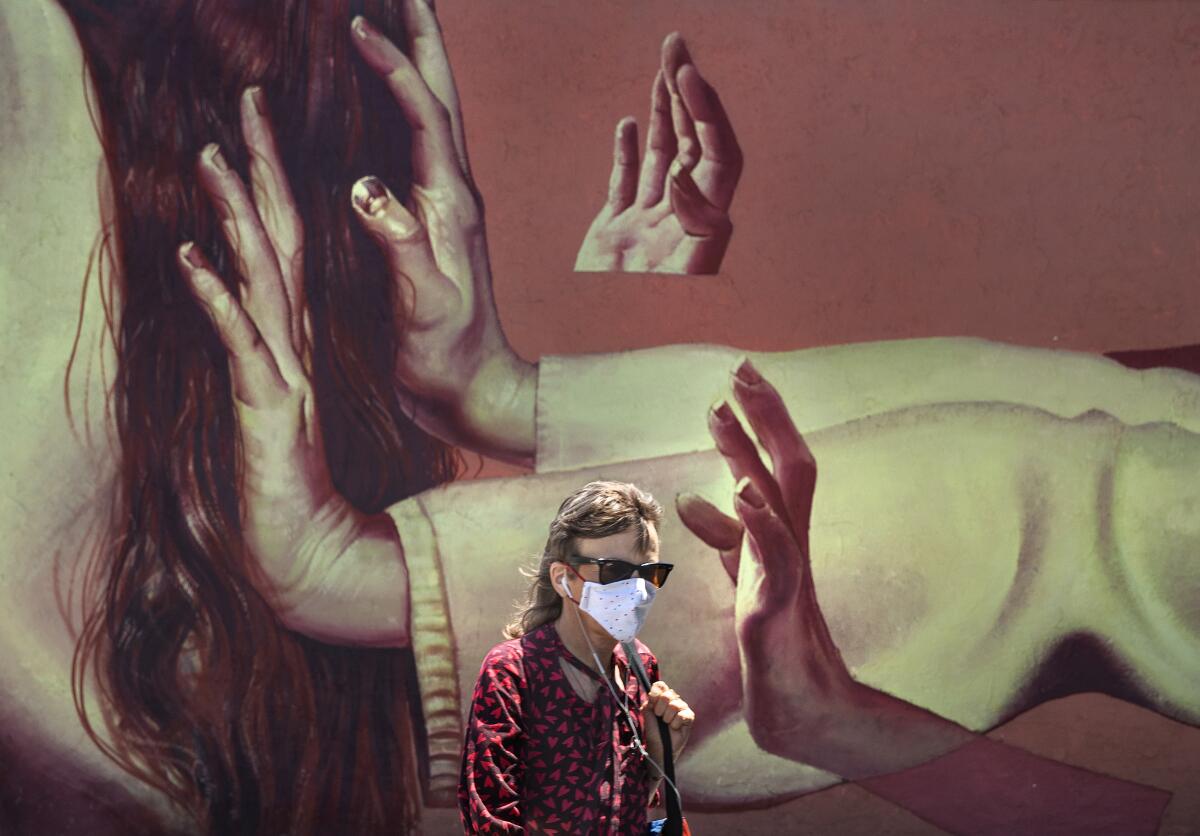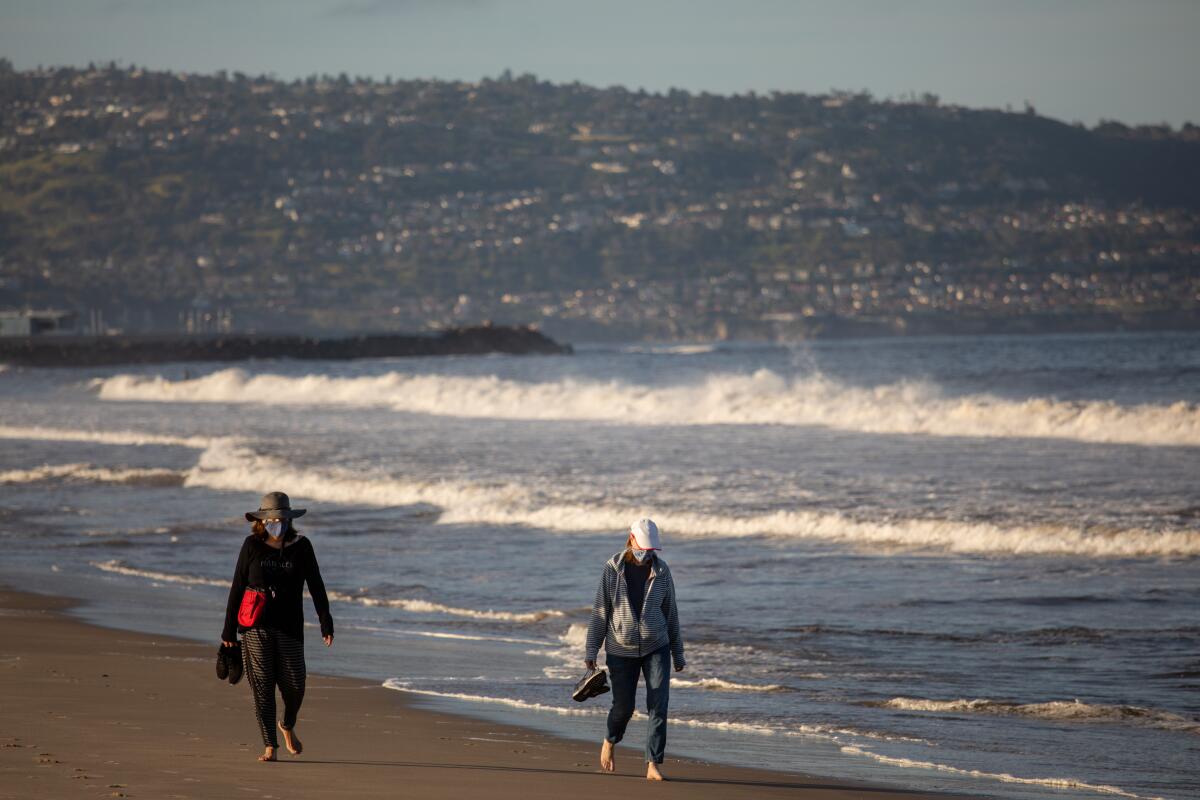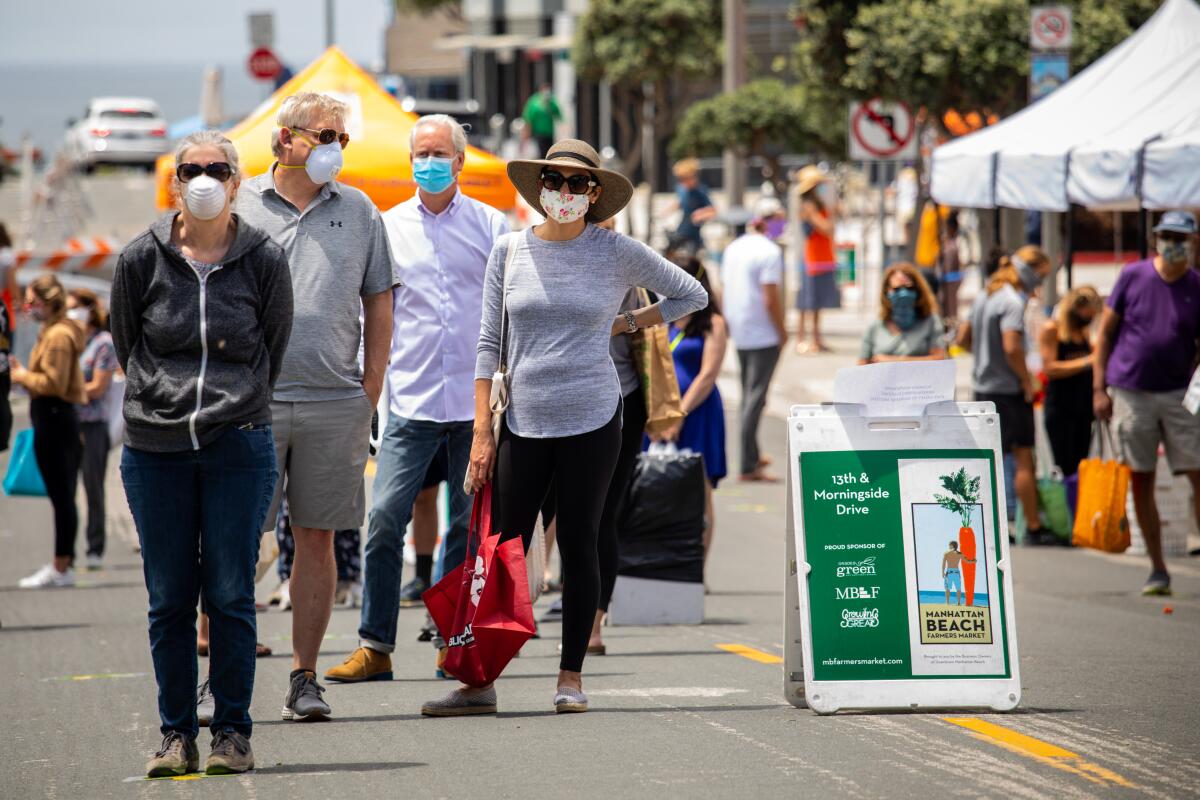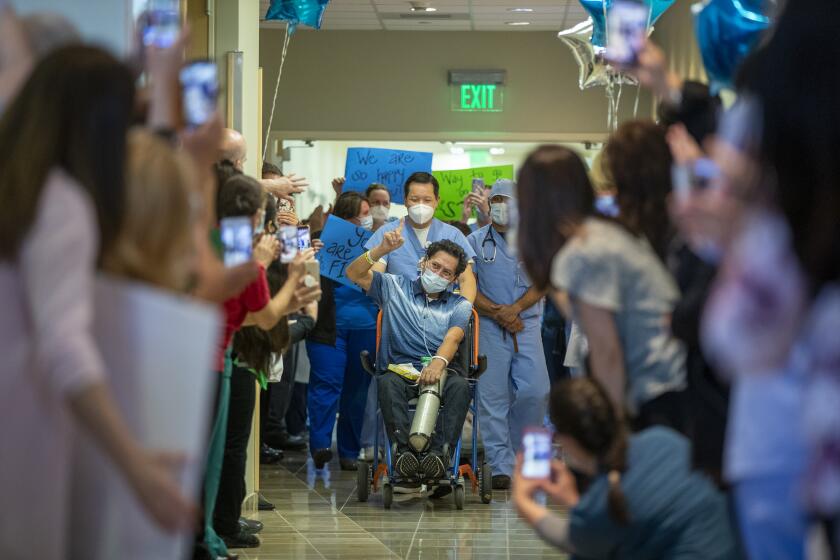L.A. requires face coverings outdoors to slow coronavirus, help lift stay-at-home restrictions

- Share via
Los Angeles County beaches reopened Wednesday and more businesses were given the green light to provide curbside service to customers, but officials made clear the region still has a ways to go before a major lifting of stay-at-home orders is possible.
L.A. Mayor Eric Garcetti announced Wednesday evening that all Angelenos, except for small children and those with certain disabilities, would be required to wear face coverings outside. That marks a significant increase in the city’s rules, but the mayor said it was a necessary step help slow the spread of coronavirus and eventually reopen the economy in a bigger way.
“Bring your mask with you whenever you leave your home,” Garcetti said. “That will help us get more freedoms.”
These are some of the unusual new scenes across the Southland during the coronavirus outbreak.
Garcetti and other officials said they remain optimistic that more aspects of the stay-at-home order could be lifted as the county saw declines in the number of deaths and new coronavirus cases.
But at the same time, the Los Angeles County Public Health Department extended the order indefinitely even while easing some of the conditions.
Still, with the changes, thousands more retails shops can reopen for curbside pickup and some manufacturing companies can also reopen.
Shops in indoor malls that do not have street or parking lot-facing entrances will remain closed.

Before any retailers, manufacturing or logistical businesses can reopen, however, they are required to implement and post plans for adhering to social distancing and infection control practices, said County Public Health Director Barbara Ferrer.
She said that there is no end date to the health order and stressed that people should stay home as much as possible to help reduce the spread of COVID-19, which has killed more than 1,600 people in the county.
“As I’ve said from the beginning, this will be a slow journey,” Ferrer said.
Recreational facilities, including golf courses, tennis and pickleball courts, shooting and archery ranges, equestrian centers and community gardens also got the green light to reopen this week.
The reopening of the beaches was a symbolic boost.
“Today was a great day for Los Angeles as people went back to our iconic beaches,” Garcetti said at a media briefing Wednesday evening. “This should be an exciting week, not a depressing one.”
But after a six-week closure, L.A.’s coast looks different than it did pre-pandemic. Visitors are not able to picnic, sunbathe or participate in group sports such as volleyball. Face coverings are required when not in the water, and only active recreation — surfing, running, walking and swimming — is permitted.
“Parking lots and piers and beach bike paths and concessions remain closed,” Garcetti said. “But let’s take advantage of what’s there, see those beautiful waves that have been glowing in Venice.”
The mayor also sought to soften Tuesday’s news that stringent public health orders would not be lifted for months to come.

Los Angeles County is the California epicenter of the coronavirus, with more than 34,000 confirmed cases. On Wednesday, officials also reported 47 new fatalities, bringing the county’s death toll to 1,660. The majority of the county’s deaths — roughly 1,300 — occurred over the last month, Ferrer said.
Other parts of California have been far less hard hit, and some of those regions are reopening much more quickly.
The state said Wednesday that 12 of California’s 58 counties — most of them rural — will be allowed to more fully reopen.
Amador, Butte, El Dorado, Lassen, Nevada, Placer, Plumas, Sierra, Tuolumne, Yuba, Sutter and Shasta have been certified as meeting the state’s conditions for additional businesses to reopen. Colusa, Glenn, San Benito and Tehama were added Wednesday afternoon, bringing the total to 16.
“This is a dynamic process and we don’t want to delay unnecessarily based on timelines,” Gov. Gavin Newsom said Wednesday during his daily coronavirus news briefing. “It’s not about timelines, it’s not about deadlines. It’s simply about data and it’s about health.”
Talks are underway with 31 other California counties to discuss whether they can expand their reopenings, the governor said, but he noted that conditions are still too serious in Los Angeles and Bay Area counties to modify guidelines for resuming business there.
Officials in Orange County continue to express frustration with the state‘s more cautious approach. They contend the economic havoc wreaked by the regulations makes it vital to loosen the rules.
“I think it’s time to open up,” Orange County Board of Supervisors Chairwoman Michelle Steel said Tuesday. “Maybe it’s too late. It’s going to be very tough to catch up.”
At least three Bay Area counties — San Francisco, San Mateo and Marin — plan to incrementally ease their social distancing restrictions starting Monday, a departure from Santa Clara County, which on Tuesday said it would not be easing its restrictions.
San Mateo had issued some of California’s most stringent shelter-in-place orders, but county health officials said Wednesday that conditions had improved enough to modify the requirements.
“I want to remind everyone these modifications are not being made because it is safe to be out and about,” Scott Morrow, the county’s public health officer, said in a statement. “The virus continues to circulate in our community, and this increase in interactions among people is likely to spread the virus at a higher rate.”
In San Francisco, Mayor London Breed said Wednesday that all curbside retailers would be allowed to reopen as of May 18 for pickup and delivery.
She had cautioned for weeks that San Francisco would be slow to reopen. But at a news conference, she said the city’s next phase meant that 95% of San Francisco’s retailers would be allowed to open starting Monday. Warehouses and manufacturers are also allowed to reopen, but the city has imposed a limit on the number of employees allowed in each business.
“We do see the numbers flattening,” Breed said. “They have not declined, but the fact is we are in a better place.” She said hospitalizations for COVID-19 remained flat and hospital capacity was stable.
Times staff writers Rong-Gong Lin II, Maura Dolan and Colleen Shalby contributed to this report.
More to Read
Sign up for Essential California
The most important California stories and recommendations in your inbox every morning.
You may occasionally receive promotional content from the Los Angeles Times.

















